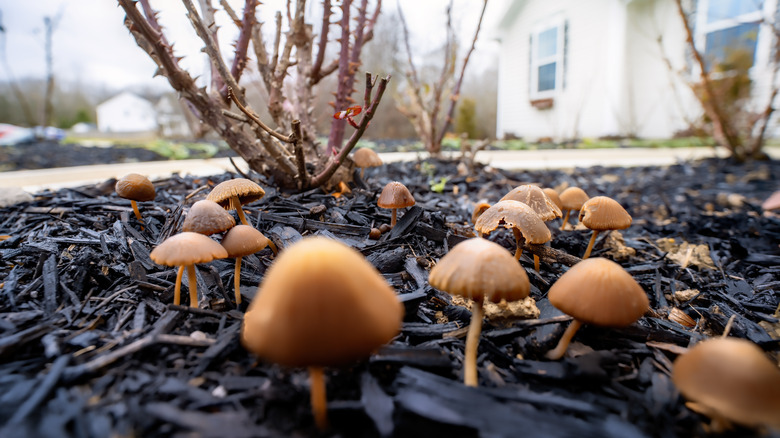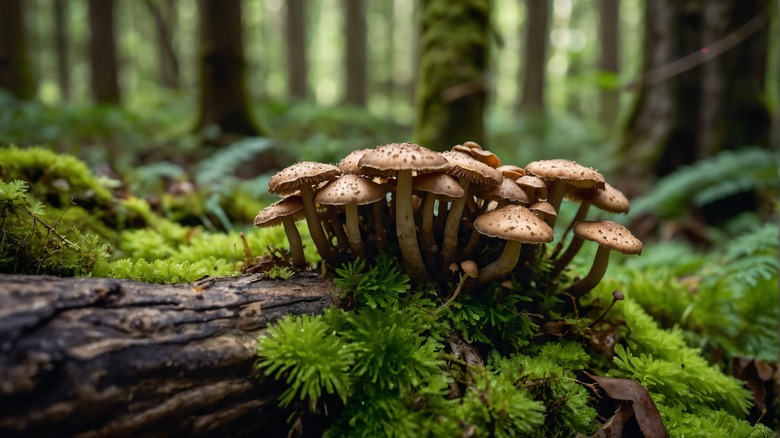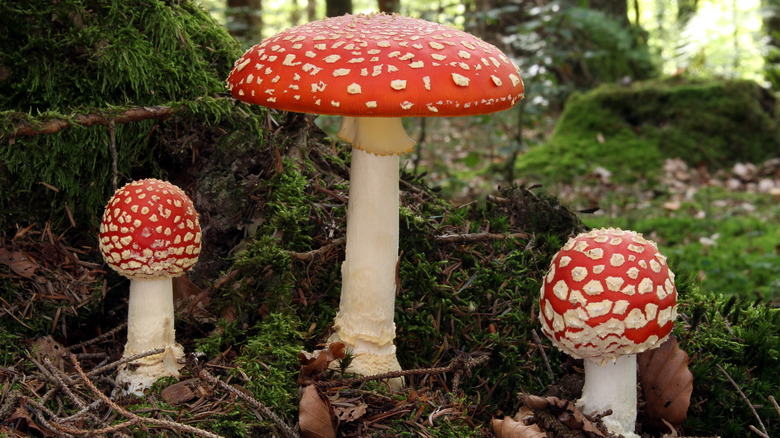Can You Tell Edible Yard Mushrooms Apart From Poisonous Ones? Our Expert Weighs In
With NOAA predicting wetter-than-average conditions this winter across much of the United States, you may find your lawn filling up with tiny mushrooms in a range of colors, shapes, and sizes. The combination of moist soil and decaying leaves creates perfect conditions for the plant-like fungi to flourish. In an exclusive interview with House Digest, horticulturist Melanie Rekola of Melanie Rekola Landscape Design told us, "There are over 10,000 species of mushrooms known to man, but many have not even been discovered yet." While some are considered a culinary delight, other wild mushrooms can cause nausea, cramping, diarrhea, or more serious health conditions like delusions — or even death. But can you tell edible yard mushrooms apart from poisonous ones?
You're probably familiar with edible mushrooms, the most common of which is the cultivated or button mushroom (Agaricus bisporus). Easy to find at your local supermarket, these mild white mushrooms account for 90% of all mushrooms eaten in the United States. Fungal favorites like Crimini or Portobello mushrooms are the exact same mushroom, just at different levels of maturity. As mushrooms age they dehydrate, concentrating their flavor and providing textures that hold up better to stewing, baking, or broiling. The average person eats three pounds of mushrooms each year, and growing mushrooms at home has become a popular trend.
"Each species is different," Rekola went on to tell House Digest. "And there aren't any common traits of all poisonous ones ... Only a few (70 to 80 species worldwide) are deadly if ingested."
Most mushrooms are non-poisonous
More than just a tasty topping, mushrooms play a very important role by breaking down organic material and dead plant matter to make nutrients available to surrounding vegetation and insects. Although they may seem unsightly, there's no need to be alarmed if they pop up around your home. "Mushrooms don't need to be removed from a lawn or garden as these are just the fruiting body of a much larger fungus below the soil," Melanie Rekola told House Digest in an exclusive interview. "This fungus below the soil is called mycelium ... It helps plants and trees connect to transfer water, nitrogen, and minerals etc. A healthy forest, landscape, and garden needs the mycorrhizal network."
You may be surprised to find several edible mushroom varieties growing in your own backyard. Hen of the Woods (Grifola frondosa), Lion's Mane (Hericium erinaceus), and Witch's Butter (Tremella mesenterica) are common mushrooms that grow on trees. Not only are they edible, along with being considered delicacies these mushrooms may also offer gut, heart, and other health benefits. Lion's Mane may help prevent cognitive decline. More generally, mushrooms are low-calorie, high in fiber, and contain important nutrients like Selenium and Magnesium.
While it is very important to carefully research any mushroom found in the wild before ingesting it, Rekola assured us, "Non-poisonous mushrooms are vastly more common." Nevertheless, it's wise to have guides on hand if foraging is in your future.
Poisonous mushrooms can harm you and your pets
It can't be stressed strongly enough that consuming poisonous mushrooms can have devastating consequences for you and your pets. Although there is no fool-proof way to spot dangerous mushrooms, there are some general characteristics present in most varieties you should avoid. Find white gills under the cap? Leave those mushrooms in your lawn. Red caps or stems? They're frequently toxic. And mushrooms with an unpleasant smell? Probably unsafe to eat.
From Death cap mushrooms (Amanita phalloides) to Fool's funnel (Clitocybe rivulosa), some deadly mushrooms could be growing in your backyard. "They don't need to be removed," said Melanie Rekola during her exclusive interview with House Digest. "But poisonous or not, you can still touch, even smell them without harm." If you want to remove mushrooms from your lawn, try a natural approach by digging them up and then pouring a few drops of dish soap in the remaining hole. Aerating the soil can introduce more air and oxygen into the soil, making it less hospitable to spores. And if those methods don't work, powerful fungicides in spray or granule form can help.
When you have pets, getting rid of mushrooms in your garden may be a higher priority. "Poisonous mushrooms are only dangerous if ingested," cautions Rekola. It's easy for pet parents to try exotic mushrooms at farm stands or fancy restaurants, but keep a close eye on your animals if they like to dig or nibble anything they can find when they're outside.


